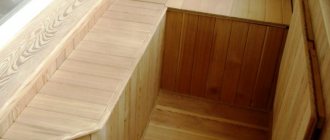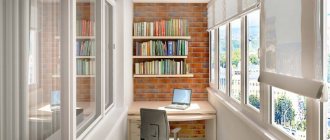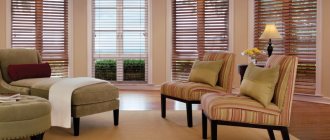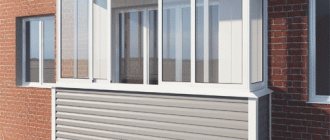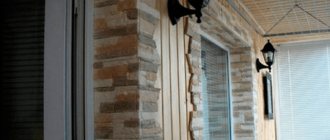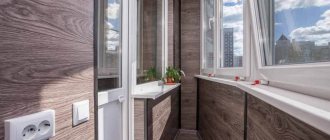Since 2001, she has been working in the field of glazing and finishing of balconies and loggias. Our team has implemented more than 3,800 projects in St. Petersburg and the Leningrad region. Wooden lining remains the traditional and also one of the most popular materials for cladding balconies among our clients. And this is well deserved! We want to share with you our wealth of experience working with this wonderful material, as well as show photos of our work.
Like any other finishing option, lining has its advantages and disadvantages. What are the pros and cons of working with lining? Is it suitable for interior decoration of loggias and balconies? What types of wood is it made from? What qualitative characteristics distinguish the “Extra” variety from grades A or C? What technical nuances should you keep in mind when working with this material?
You will find answers to these and many other questions in this article.
What is lining?
The lining consists of thin boards (lamellas) made of dried wood with a smooth planed front surface. All boards have the same specified dimensions and locking joints (recesses and protrusions) on the long sides. This ensures a reliable connection to each other using the tongue-and-groove principle and rigidly connects the mounted lining to each other.
Previously, this material was made from wood waste and was originally used as an inexpensive lining for carriages, which is why it got its name.
Over time, thanks to the development of technology and the expansion of the range of wood used in the production of lining, this finishing material began to be used everywhere. The variety of board profiles, textures and the use of different types of wood allows it to be used in the interior design of any premises, including loggias.
Prices for finishing loggias with clapboard
In order to become more familiar with the technical and decorative characteristics of lining, let's talk about the classifications of lining.
By type of wood used
Wood, as a material for the production of lining, has the following properties: naturalness, environmental friendliness, high thermal insulation (in other words, low level of thermal conductivity). Theoretically, lining can be made from any type of wood, but due to high humidity and temperature changes, not any wood is suitable for finishing balconies and loggias. The type of wood determines the performance characteristics of the lining, its aesthetic properties and, of course, affects the cost of finishing.
The following types of wood are used for cladding balcony premises:
- conifers (spruce, pine, cedar);
- deciduous (aspen, linden, abash, larch, ash, oak).
The most popular finishing option remains lining made of spruce and pine. Due to the affordable price and good quality, most of our customers choose this cladding. Untreated wood fills the room with a pleasant pine aroma of tree resin and has antiseptic properties. The disadvantages of spruce lining are its resin content and a large number of knots.
In the middle price range there is lining made from the familiar aspen and linden, as well as from abash wood (African deciduous tree). The advantages of these wood species are that they have optimal elasticity and strength, as well as low thermal conductivity properties. This lining does not heat up and is ideal for finishing balconies facing the sunny side. The surface of the board has a less expressive texture, but this can be easily compensated for using various decorative compositions for wood processing.
Larch lining has a beautiful pattern of wood rings and a variety of color shades: from light golden to red-brown. In terms of strength, it is comparable to oak products. Siberian larch has high moisture resistance and frost resistance, and is not susceptible to rotting. After some time, resin appears on the surface of the lamellas, which cannot be disguised under a layer of decorative coating. For this reason, we do not recommend using larch on the balcony, especially if it is on the sunny side.
The expensive price segment includes lining made of noble species: oak, ash and cedar. These finishing materials are durable, resistant to moisture, rich in texture and wide color palette. In the interior, these species are often not painted, trying to preserve the natural beauty of the wood. Installation of such lining is more difficult, since this wood is very hard and you have to drill holes before driving in a nail or screwing in a self-tapping screw. Due to the high cost, such lining is rarely used for finishing balconies.
By class (grade) of wood
Class C
Low-quality lining left over after rejecting higher grades. There are multiple defects on its surface: unplaned areas, falling knots, resin traps, cracks and rot. It is used for finishing utility and non-residential premises or as lathing.
Class B
The lining is of average quality. There can be up to 1 falling knot per 1 linear meter of lining; up to 4 non-falling knots with a diameter of up to 20 mm are allowed. Non-through cracks may be present in any quantity. These defects can be hidden under a layer of putty and paint. This type of lining is more suitable for finishing utility rooms.
Class AB
Mixed grade A and B. The wood content of grade B should not exceed 10% of the total. You can combine different classes of wood, using lower-grade slats in inconspicuous places, and still save a little.
Class A
On grade A lining, the presence of visible defects on the front side is not allowed: knots with a diameter of more than 1 cm and through cracks. Roughness can only be present on the reverse side.
Extra class (or Premium)
This class is represented by lining of the highest category with a perfectly smooth surface and visible pattern. There are no flaws on the surface. It is possible to manufacture Extra grade lining from laminated wood, but such material is not suitable for rooms with changes in temperature and humidity. Over time, a can cause the glued joints to dry out and make them noticeable.
For finishing balconies, lining of a class not lower than AB is used. Attempts to save money when purchasing a lower grade of wood usually take their toll. Due to multiple defects in low-grade lining, a large amount of waste is generated during installation. For this reason, the amount of purchased materials increases and installation becomes more complicated.
By appearance
Eurolining
- one of the most common options for lining, which can have any grade: from “Extra” to C. Along the tenon, the board has a longitudinal chamfer (bevel) and after laying, clearly defined groove stripes are visible on the finished surface. Eurolining is resistant to changes in humidity and is perfect as a finishing material for balconies. Eurolining has been used for many decades, which is why it may seem like a somewhat outdated option.
"Softline"
- is a more modern version of eurolining, in which the chamfer (bevel) along the long edge of the lining does not run at an angle, but has a rounded shape. Due to the absence of corners, the coating is protected from chipping and looks a bit like a “block house” (imitation of a log). "Softline" is also suitable for balconies and loggias.
Lining "Calm"
— has rounded edges, it lacks the chamfer characteristic of eurolining. After assembly, the surface resembles a wall made of wooden beams. The thickness of the lamellas is 2.5 mm. The finished coating is susceptible to high humidity, so it must be coated with protective agents.
"Tasa"
- a modern version of decorative wooden panels, which are manufactured in high-tech production. "Tasa" has a cone-shaped lock fastening, which makes its installation simple and quick. The lamellas fit tightly to each other and barely noticeable joints-recesses 1 mm deep remain on the finished canvas. The coating does not tolerate dampness and requires the application of a protective layer. Treatment with decorative protective agents gives Tasa an excellent appearance.
"Block house"
– differs from other profiles in that the front side has a rounded shape and the surface after installation imitates a wall made of rounded logs. When glazing and interior finishing of the loggia with clapboard, it is necessary to take into account the technical nuances of the work associated with the difference in profile heights due to the uneven rounded surface. When finishing the corners of the loggia with such clapboard, difficulties may arise with the joints.
Imitation of timber
- false beams have a thickness of 16 to 28 mm and coarser joints. Its task is to imitate the laying of timber, so for small interior spaces, such as a balcony, such a coating may look somewhat rough.
American
- this is a lining that has a beveled profile of the slats and is attached with a visible overlap on each other, creating the effect of siding. Unlike other types of lining, which can be attached in any direction (vertically, horizontally, obliquely), “American” has a strictly horizontal laying direction. Due to the fact that technologically this type of lining was created for the external cladding of facades and its design was developed to protect against precipitation, “American” will be a good option when finishing a balcony both from the inside and from the outside. However, the installation of such lining is quite complicated.
By size:
In Russia, GOST 8242-88 is in force for the production of wood parts, developed and put into effect since 01/01/1989. This standard does not provide specific dimensions for lining, so manufacturers have the opportunity to produce various options suitable for covering any premises.
The most popular profile - eurolining - has standardized dimensions. Most often on sale you can find lining made of coniferous wood in the following standard sizes:
- Working width – 88 mm.
- Total width – 96 mm.
- Thickness – 12.5 mm.
- Length – 2.2 m, 2.5 m, 2.7 m, 3 m.
- Quantity in 1 package – 10 pcs.
Of course, you can find lining of other dimensions, but these sizes are most often used for cladding balconies.
Marine style balcony
As a rule, a balcony serves two functions. It can be a place to store seasonal items or a relaxation corner. In the latter case, marine themes are often used for interior decoration. It helps you relax as much as possible and abstract from the everyday hustle and bustle. When creating a marine interior, it is customary to rely on “three pillars”:
- White and blue colors when choosing textiles;
- Decor in the form of ship attributes;
- Lining imitating deck finishing.
For greater realism, the wood is tinted or aged. You can purposefully purchase a darker lining. For example, New Zealand thermopine or Canadian cedar by default have a richer, deeper shade, but they are slightly more expensive than the usual linden, pine and aspen.
Advantages and disadvantages of lining for finishing a loggia
Advantages:
- Environmental friendliness of natural material.
- The special charm and comfort of the interior, designed in natural tones.
- Safety for humans, pets and indoor plants, hypoallergenic.
- No release of toxic substances when heated.
- High thermal insulation properties, allowing for high-quality insulation of the balcony with clapboard.
- Good noise absorption.
- Increased impact resistance compared to PVC panels and plasterboard.
- Good degree of resistance to static and dynamic loads.
- The appearance of the lining can be easily refreshed or even changed in color using a decorative wood coating.
- The ability of wood to absorb and release moisture, which reduces the risk of condensation.
Flaws:
- High degree of hygroscopicity - it is not recommended to use the material in rooms with high humidity.
- It is highly flammable, which is why the lining cannot be used for finishing open balconies and requires electrical installation work to be carried out by professionals in strict compliance with all fire safety requirements.
- Heterogeneity of the material. There may be knots, some unevenness, and roughness on the surface of the lining.
- Wood finishing may seem like an outdated finishing option and is not suitable for lovers of modern interiors.
- After some time, the material requires updating the protective layer, otherwise bugs and mold may appear in the hardwood.
- Resin may be released on the surface of the softwood lining.
Maxim Tsebro measuring engineer
What tools are needed for installation?
If the owner of the apartment is faced with the task of covering the balcony with clapboard with his own hands, then a minimum set of tools is required.
This set may include the following tools:
- Rotary hammer with a set of drills of the appropriate diameter
- Screwdriver with bit set
- Electric jigsaw, with saw set
- Roulette
- Drywall knife with a set of blades
- hammer
- Pliers
- Pencil
Stages of work
Preparing walls and ceilings
The old cladding is dismantled, peeling pieces of paint, plaster, etc. are removed. If necessary, an anti-fungal coating is applied to the old surface, and the walls and ceiling are coated with a windproof compound (STIZ sealant or analogues).
Cleaning plastic frames
Cleaning is carried out in cases where the balcony glazing is dirty or installed more than a month ago. Special products are used for cleaning (example: Cosmofen).
Insulation
When installing insulation between the sheathing bars, cold bridges appear.
To prevent their formation, it is recommended to fasten the expanded polystyrene sheets without breaking even before installing the sheathing. The fasteners are made directly to the old walls using special plastic “fungi”. Such a closed fastening without gaps will make the balcony warmer and protect it from blowing air. In some cases, additional sealant is applied to the insulation seams. Mineral wool is rarely used for insulating balconies. This is due to the need to install additional vapor barrier (cotton wool can absorb moisture from the air) and ventilation gaps, which reduces the usable space of the loggia.
Installation of the reflective layer
An optional step that is used only in residential projects where additional energy savings during heating are planned.
A stenophone or its analogues is used. If the balcony is located on the sunny side of the house, it is not recommended to lay a foil layer, since in this case the temperature on the balcony will be higher than normal.
Installation of subfloor
This stage is not directly related to clapboard cladding, but precedes the finishing work. The quality of installation of the subfloor, in the end, is of great importance for insulating the balcony. An important point: the floor insulation must fit into the insulation on the walls without gaps.
Installation of sheathing
After installing the subfloor, a sheathing of wooden slats or bars is installed in the direction of the lining.
If the old walls are smooth, substandard lining can be used for lathing. The lathing is attached horizontally for vertical installation of the lining, and vice versa. You can only use dry wood of at least grade B with a section of 20x30, 20x45, 30x40, 40x40, 45x45.
The lining can also be laid diagonally, but it should be borne in mind that in this case its consumption will be 25-35% higher due to the large number of scraps.
Installation of hidden wiring
Electrical wiring is carried out in parallel with the installation of the sheathing. Distribution boxes are installed, recesses for sockets, switches, lamps, floor thermostats, etc. are marked. Niches are made for installing a transformer for decorative lighting. Considering the high flammability of wooden lining, it is important that electrical installation work is carried out by professionals in strict compliance with fire safety requirements.
Installation of lining
The wooden material is secured using hidden fasteners (clasps) or decorative (not black!) screws. If you plan to paint the surface further, the heads of the screws can be hidden using a special putty for wood. After applying the paint, the fastening points will be almost invisible. All external corners are decorated with wooden corners and/or platbands, and internal corners are decorated with fillets, plinths and/or layouts.
Advice. Before sale, the lining is dried in drying chambers until a moisture level of 10-15% is reached. If the humidity in the room is significantly higher, the wood will absorb moisture and may swell. To prevent this from happening after installation, leading to deformation and spoiling the appearance of the coating, open the package indoors and let it “breathe” for 1-3 days. The second option for solving this problem: do not push the lining tenon all the way, leaving a gap of 1.5-2 mm in case of further expansion of the material.
Painting
Depending on the interior design project, after installation, a decorative glaze coating can be applied to the surface of the lining, emphasizing the structure and pattern of the wood, or a covering coating. This stage is not mandatory, but the treated wood yellows less and ages more slowly under the influence of ultraviolet rays, temperature and humidity changes. The protective coating prevents the appearance of microcracks and fungus. To process the lining, the following are used: natural oils, varnishes, acrylic paints, stains, and tinting compounds. You can see the interior finishing options in the photo.
Installation of electrical fittings
The final stage of all work is the installation of electrical fittings (lights, sockets, switches, etc.). It is carried out only after the paint has dried.
Features of the material
Wooden cladding boards are used for interior decoration. Any type has excellent performance characteristics and an attractive appearance. Natural material is easy to install thanks to special locks on each element. Profiled boards can be made from any type and type of wood. More often they use pine, oak, linden lining.
Wooden panels are very flexible, which makes them easy to process. When installing or repairing individual elements, you can use hand tools. The special configuration provides the lining with a number of advantages. Convenient width and thickness, the piece nature of the panels have a positive effect on the weight of the material. One person can handle the installation of compact lamellas; there is no need to assemble a powerful frame and overload the base to install wooden parts.
The panels are installed using a tongue-and-groove method, the wooden boards cover each other with an overlap of 5-8 mm. This allows you to avoid the appearance of cracks when temperature and humidity levels change. Thanks to special fastenings, metal clamps, the appearance of rises, cracks and other types of deformations on the lined surfaces is excluded. Moreover, all fasteners are hidden behind a smooth, decorative surface.
Gallery of completed projects
For a better understanding of what the interior decoration looks like, here are photos of our actual work.
Only real photographs of our work are used on the site.SEE ALL OUR WORK
The most practical options
A widely popular method of finishing is unpainted lining with a light coating of the surface with varnishes of transparent and semi-matte structures. This will allow you to fully enjoy the luxury of natural wood texture. The natural beige-brown range of shades has a calming effect on the human nervous system and will allow you to quickly cope with stressful situations.
As an experiment, you can provide an original finish with skirting boards of other colors (often darker or, on the contrary, much lighter than the base), this will give the interior some playfulness and will hide possible cracks and uneven joints.
Adherents of everything natural can not stop only at clapboard covering, but make the necessary wooden furniture (perhaps even specially built around the perimeter of the balcony), ideally matching the color with the general background. This makes it possible to simultaneously make the room as functional and comfortable as possible.
Advantages of working with our company
We do it beautifully and reliably
As for myself. We offer comprehensive technical solutions for insulation and finishing of loggias and balconies. Even at the measurement stage, we provide a huge selection of materials and design solutions.
The experience of each of the masters is at least 7 years
Professional specialization in finishing loggias, knowledge of each technology and compliance with the requirements of SNiP/GOST - these are the specialists who work for results.
Own window production since 1996
The staff includes engineers and designers. We use proven technologies for sealing and insulating balconies or loggias.
We coordinate documents with the management company
We independently prepare project documentation and individually coordinate projects for glazing replacement with the management company.
We work honestly.
We offer only effective technical solutions for glazing and insulation. We do not offer economical solutions that, due to low prices, will come at the expense of quality.
We carry out complex work
Starting from replacing cold façade glazing from the developer to transforming a balcony or loggia into a cozy living room for year-round use.
We provide factory warranties
For glazing of balconies and loggias – up to 10 years. For all insulation and finishing work – up to 5 years, depending on the materials chosen.
0% installment plan and convenient payment methods
We offer a step-by-step calculation with full payment only upon completion and delivery of the finished premises. There is always the opportunity to order all work in installments without overpayments.
Summarize
If we are solving the problem of how to cover a balcony with clapboards with our own hands, then before starting the work we need to prepare all the necessary materials and tools in order to then quickly and efficiently complete all the necessary work.
In this case, you should first study the drawings and make a list of work to be performed.
